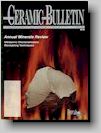| Boron Nitride |


Fig. 1. SEM micrograph (secondary electron image) illustrating the platelike particles of a ceramic-grade boron nitride powder. |
Fig.
1 | Table 1 (chem. data) | Table
2 (production) | Table 3 (consumption)| Properties
| Synthesis | Production
| Companies | Consumption
Hexagonal boron nitride (a-BN) is a white, talclike powder that has a graphitelike sheet structure. Therefore, it is often referred to as white graphite. In contrast to graphite, it has localized p-electrons that are responsible for its high electrical resistivity and white color. Furthermore, boron nitride is a high-temperature solid lubricant, good thermal conductor and good dieelectric. It is chemically inert and not wetted by many metallic and silicate melts. Boron nitride is stable in air up to 1000°C, under vacuum up to 1400°C and can be used to 2400°C in a nitrogen-gas atmosphere. Boron nitride is available as a powder with BN concentrations ranging from as low as 92% for refractorv purposes to >98.5% for ceramic applications. High-purity grades are >99.5% BN. Boric oxide (B203), carbon, oxygen (forming amorphous boron oxynitride) and metallic impurities may be present. Boron nitride does not occur in nature and was first prepared in 1842 by reacting molten boric acid with potassium cyanide. However, commercial production was initiated in the 1950s. Three synthesis routes are used today. Boric oxide, borax, boric acid or calcium hexaboride may be the source of boron, which forms boron nitride in the presence of ammonia (by using an inert filler), an organic nitrogen-containing compound (e.g., urea) or nitrogen gas, according to one of the following reactions: |
|||||||||||||||||||||||||||||||||||||||||||||||||||||||||
|
||||||||||||||||||||||||||||||||||||||||||||||||||||||||||
|
||||||||||||||||||||||||||||||||||||||||||||||||||||||||||
| No statistical
figures are available on the production levels of boron nitride, but a
reliable estimate is about 220 metric tons in 1993 for the western world,
one-third of which was produced in each the United States, Europe and Japan.
Although boron nitride is produced in the Commonwealth of Independent States
(CIS, formerly the Soviet Union), no information can be obtained from there.
The principal producers include Advanced Ceramics Corp. (formerly Union Carbide/Praxair Advanced Ceramics) and Carborundum Co. in the United States; Boride Ceramics & Composites Ltd. in the United Kingdom; Elektroschmelzwerk Kempten GmbH and H. C. Starck GmbH & Co. KG in Germany; and Denki Kagaku Kogyo, Kawasaki Steel Corp., Shin-Etsu Chemical Co. Ltd. and Showa Denko KK in Japan. The costs of boron nitride powder for lots of 100 kg are about $70-$80/kg for refractory grades and $100-$120/kg for ceramic grades. High-purity and tailor-made grades may be purchased at prices ranging from about $200-$400/kg, depending on quality and size of order. |
||||||||||||||||||||||||||||||||||||||||||||||||||||||||||
|
||||||||||||||||||||||||||||||||||||||||||||||||||||||||||
| Large quantities of boron nitride powder are used for the production of titanium diboride/boron nitride intermetallic composites, such as evaporator crucibles and boats for vacuum metallization of plastics and glass. Considerable amounts are used for refractory purposes and the production of break rings for horizontal continuous steel casting. Dense shapes of hexagonal boron nitride are made by bot isostatic pressing (HIPing) of powders using boric oxide as a sintering agent; this consumes 15-25 metric tons/year of boron nitride powder. The resulting shapes are soft and easily machined to desired sizes. | ||||||||||||||||||||||||||||||||||||||||||||||||||||||||||
|
||||||||||||||||||||||||||||||||||||||||||||||||||||||||||
| Hexagonal boron nitride is also the
source of cubic boron nitride (ß-BN, a diamond-like modification
with zinc blende structure). 15-20 metric tons/year are used for this conversion
- however, the output is only 5-10% cubic boron nitride.
An increasing amount of boron nitride is used in paints and coatings that act as release and lubrication agents for light-metal casting, and glass and other forming processes such as superplastic forming of titanium sheets for aerospace and defense applications. The paints are dispersions of boron nitride in a carrier (water or alcohol) - often blended with refractory binders-that can be applied similar to household paints. Certain formulations are available in aerosols for easier application. Such coatings are produced by Advanced Ceramic Corp., Carborundum Co. and ZYP Coatings Inc. in the United States and by Elektroschmelzwerk Kempten GmbH and Büro für angewandte Mineralogie in Germany. Because of its good thermal conductivity, high dielectric strength and nontoxic nature, boron nitride is used as an alternative to beryllia in electronic applications for heat transfer between semiconductor chips and their substrates. Latest developments show applications of boron nitride in cosmetics because of its good lubrication properties. Boron nitride-producing companiesare encouraged to submit more precise data on production and use for next years Annual Minerals Review. - Submitted by Stephan Rudolph,Büro
für angewandte Mineralogie, Tönisvorst, Germany
|
||||||||||||||||||||||||||||||||||||||||||||||||||||||||||
| from: American Ceramic Society Bulletin, 73 (1994) 6, pp. 89-90 |
|
|
|
|